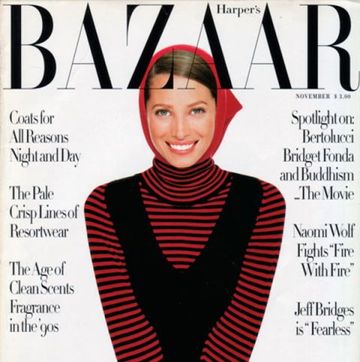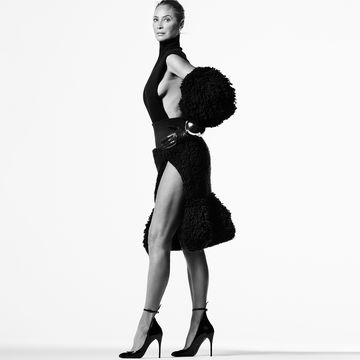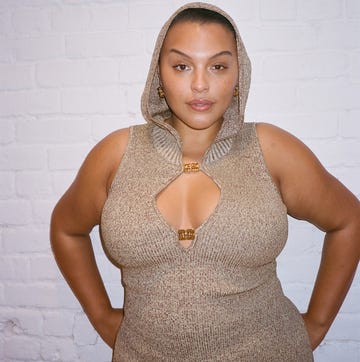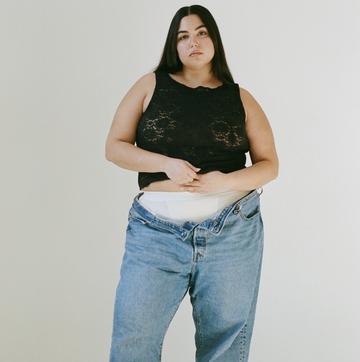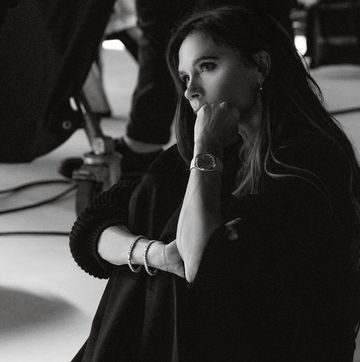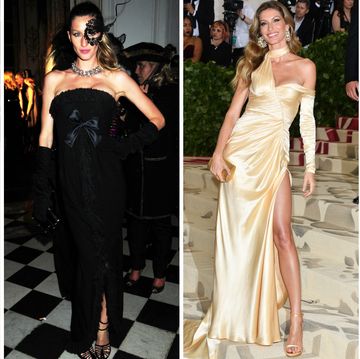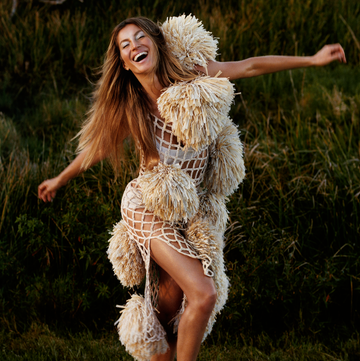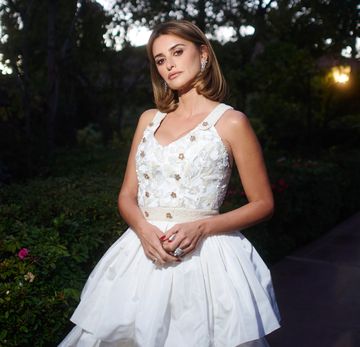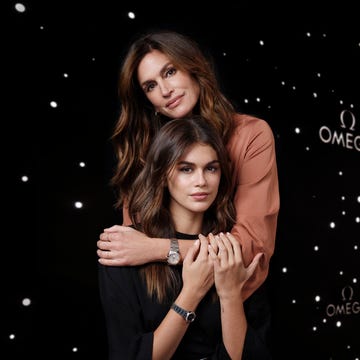Fern Mallis kicked off her fifth year of "Fashion Icons with Fern Mallis" at NYC's 92Y with a bang last night—she brought out supermodel-turned-makeup mogul Iman for a Q&A session on topics ranging from her turbulent childhood as the daughter of a Somalian diplomat and being discovered on the street by photographer Peter Beard to her battle against racism in the fashion industry and her marriage to David Bowie. Read on for the highlights from the chat.
On her age: We all have friends and loved ones who say 60's the new 30. No. Sixty's the new 60.
On having a Somalian boy's name: The Somalians cherish their sons. but for five generations my family had all sons, no daughters. My given name was Zahra, which is the "flower of the desert." I don't look anything like the flower of the desert. My name was changed by my grandfather to Iman, which means "have faith." And it meant to have faith that a daughter would come. I've been teased my whole life about that but I've literally grown into my name. But my daughter is called Alexandria Zahra Jones.
On her childhood: We were very, very poor but somehow as children we never experienced it. We were never hungry but that's what we came to know. [My parents] were both very political and doing two, three jobs at the same time so that's the environment I grew up in. They encouraged education, especially for me, as a Somali Muslim girl, because that would propel me to any height.
On her mother sending her to boarding school: I resented my mother for it and we really had a tough go, but then I found out she sold all her jewelry to pay for my education. That was the best school for girls in my country.
On living as the daughter of the Somali ambassador to Saudi Arabia: I studied in Italian when I was in boarding school, so overnight when we moved to Saudi Arabia we were taught in English. I speak five languages besides mine. I went to school in Egypt because girls weren't allowed to go to school in Saudi Arabia. It's very restricting, especially for girls, we're not allowed to go anywhere.
On becoming a refugee from Saudi Arabia: Imagine: we have our own chauffeur, our own car, we're going everywhere with security, as [the family of the] ambassador. Then Somalia had a revolution and it became a military regime. All embassies were closed, and all of a sudden people my father worked with disappeared. So my mom decided, 'Why would we wait for that to happen?' So, in the middle of the night, she gets a van, puts us in with nothing but the clothes on our backs and we drove to the border of Kenya and crossed on foot. I literally have two pictures of myself growing up. I am the face of the refugee. The refugees are, 99% of the time, people who have left their countries for fear for their lives. It's not people who want to come to other countries and be pariahs. That's not what a refugee is.
On being discovered by Peter Beard: I was walking to [my job as a] waitress and Peter Beard appeared and started talking to me and asked my name and I thought he was trying to pick me up. He followed me and asked, have you ever been photographed? And I'd never seen a magazine in my life—except my brothers were teenagers and they had Playboy. And I said, "I'm not that kind of girl." He talked about his profession and I didn't pay attention and then he said, "I'll pay you," and then I stopped. He said, "How much?" I said, "$8000." (That was two year's tuition.) And he said, "OK." I brought two girlfriends, he took the pictures, I thought, "That was an easy job, $8,000." He wrote me a check, I cashed it immediately.
On being naked from the waist up in the photos: I definitely looked at those as art. First of all, you couldn't see my nipples. And I chose them because he showed them to me. And he's still my favorite photographer because he saw in me what I have never seen in myself. And I don't know how he saw it.
On how she came to New York: "One of the pictures he took was on an invitation and Wilhelmina [Cooper, founder of Wilhelmina Models] saw it. [Beard] said, "Oh, she's in Kenya" and he said, "Let's call her." Half the stuff she said I couldn't understand. She said, "Come to New York, you can have a business, you can make $250,000." I said, it has to have a return ticket. I still have the ticket. [But] I always planned to come home. I was married. I was not 18 so I could not leave the country without the permission of my parents or my husband (pfft, my husband, that was gonna go anyway). My mother was so upset with me. It was my parents. My parents would never sign a paper for me to go to America. So I forged. I said, "I'm a refugee, I don't have a birth certificate."
On finally coming to New York: I arrive in New York on October 15, 1975. On my own, by the way. Three months before, Eugenia Sheppard wrote a full-page article with a picture of me by Peter Beard in the New York Post and she writes that I was discovered by Peter Beard goat herding. I was like, 'what?' It said, "She doesnt speak a word of English."
How she got a visa to work in the U.S.: You have to understand, I didn't know makeup, I'd never worn heels in my life, I had no concept what was going on. I didn't have a working visa. If you're a working model you have to have tear sheets that prove you worked somewhere else before. You have to prove that you're a model before you come here. I didn't even know what tear sheets are! It was a tough go, everyone's trying to figure out how to get me a visa. Halston was a friend of Peter Beard, Diana Vreeland...I met Veruschka…this is the world I was thrown into! These people actually wrote letters to the immigration department saying how great I would be to the industry and that's how I got my working visa.
On meeting Halston: He permanently had a cigarette in his hand and a hand in his pocket and he said, "Darling, can you walk?" And I said, "How the fuck do you think I got here?"
On when Essence editor-in-chief Marcia Gillespie called her a "white woman dipped in chocolate": You know how infuriating that is to me? It was actually shown to me by a Time magazine journalist, like, "would you like to reply?" I said, "Oh no." You have to understand that I'm a very political person and I know everything has repercussions and I didn't want to talk to a white journalist about a war with a black magazine. I went to her office, closed the door and we had a conversation. I have more black in me than any black person in America. I have no white in me, I'm 100% Somali. I never thought in my life before I came to America, 'I am a black woman.' In Somalia, we're all black. That's another thing I had to learn. Now the first thing that comes out of my mouth is, "I'm black."
On the pay divide between white and black models: They had a certain hourly rate for white models and different for black models. It's the same services! They say, "you worked for me," and I said, "No, you hired me for a service." I said, "I'm not going to a job unless I get paid the same." Someone had to say it.
On her advice to young black models: Don't think you don't have a voice. You have a voice!
On being muse to Yves Saint Laurent: I was with him over a month. They gave me very silky black pantyhose with the line at the back, black pumps and a white robe, and you just wait for Yves Saint Laurent. You take the robe off and you'd stand there and he'd work all day. I saw it from the inception. All these colors that you think would clash and then so harmonious! And Loulou was there with this gorgeous coral jewelry…
On the taxi crash that nearly killed her: I was coming from dinner on my way home and right on First Ave and 37th Street, I was in a taxi and a car hit us and the whole taxi overturned. This side [gestures to her left side] of my face was broken. It's all wired from the inside. It didn't shatter, it broke in pieces and it took forever to heal. With the magic of makeup no one knows.
On her boob job: Oh, God, I never live that one down! It's not even that large, mind you. Would you even think I had breast enlargement? No! But after having my daughter I just wanted to have it done. But I've never lived it down, including the designers, they hate it! They come to terms with both of them but they say, "what did you do? You crazy girl!"
On her makeup line: The seed of my makeup line was my third day [as a model] and the makeup artist came to me with a perplexed look and said, "Did you bring your own foundation?" I didn't know what he meant but I saw he didn't ask the white model. I watched him mix and mix and looked in the mirror and I was gray. I thought the magic of the camera could fix it but my career could have stopped there. But the gods of fashion and beauty were smiling because the pictures were black and white. Black and white hides a multitude of sins. So after, I went to every store I could find. I bought all their foundations. I mixed and mixed and I would put on my face and take a selfie. At the end of the day as a model my currency is my image. It's all about, "Is she good in photographs?" So I wanted to make sure I had some kind of control over my image. Armed with that I made a batch and I'd always have it with my bag, to the point where it comes to fashion shows, all the black models would come to me and say, "Can I have some of that?" But all black models never leave home without a bottle of foundation and that makes me seethe. It's such laziness on the part of the makeup artist! That's your job! It's like me coming to a shoot and asking the photographer, "Did you bring your camera?"
On her daughter, Alexandria: We tried to get pregnant for seven years. I was at a shoot and Christie Brinkley walked in and she had a baby. So I said, "in Africa, if you carry another woman's baby for a day, you'll get pregnant." And she said, "Here!" So I carried the baby all day. I do say it took two blondes to get me pregnant—Christie and David! I was 44 years old—you hear about the miracle of birth, but no it's the miracle of conception. That's a miracle.
On being married to David Bowie: Funny enough, he goes to museums, shows, music shows, especially young musicians that he likes, he takes his kid to school…I'm not married to David Bowie, I'm married to David Jones. I've never had members of the press in my apartment. At home, it's home. You retain the difference between a person and a persona. And people say, "Oh, you can't have a private life." If you want it, you can.
On the dearth of black models on the runway: What happened in the old days is that designers used to see the models themselves. But now designers have too many collections and they hire casting agents…they tell the agencies, "We're not hiring black models this season." Tell me that's not racist. For the life of me I don't understand. You say, "I love Beyoncé and Rihanna, but I don't use black models." What the hell is that?
The best advice her parents gave her: That I can do anything better than the boys. For a Muslim girl, that really propels you.

Julie Kosin is the senior culture editor of ELLE.com, where she oversees all things movies, TV, books, music, and art, from trawling Netflix for a worthy binge to endorsing your next book club pick. She's the former director of audience strategy and entertainment at HarpersBAZAAR.com. When not glued to her laptop, she can be found taking pictures of her dog or haunting used bookstores.

